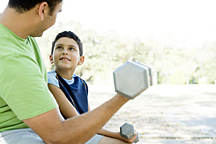Start Them Off Right
Safe Exercise Strategies for Adolescents and Teens
By Perry Nickelston, DC
These days, if your child is interested in or already involved in competitive sports, or even if they're just looking to "shape up" for summer, weight-lifting and other forms of training may be an everyday routine. But wait - they're only kids and their bodies are still growing. It's important to understand the right (and wrong) way to exercise so your children can avoid injury and burnout.
Exercise, fitness, and sport-specific training are more popular than ever, and interest and participation aren't limited to the adult crowd. Gyms and health facilities are flooded with parents wanting to give their kids the competitive advantage. There is increasing societal pressure for kids to look a certain way physically or perform a certain way on the playing field. The desire to be number one can set the stage for improper training, overtraining and injury.
Kids pick up the latest fitness magazine and start training like their favorite athletes do, thinking they can be just like them if they push hard enough. Unfortunately, their bodies are usually not ready for this level of training, and they can easily develop abnormal patterns of muscle movement and function. These abnormal patterns inhibit athletic performance and, if left uncorrected, may cause permanent injury. Let's review the five biggest exercise mistakes youngsters can make, along with some safe and effective alternatives.
Mistake #1: Starting Weight Training Too Soon
 The Wrong Way: The number-one cause of injuries and poor performance (by far) is improper weight training. Introducing weight resistance training too soon causes abnormal vector stresses on the growth plates in bones, elevating injury risk significantly. Although injuries can occur at any age, youngsters in their preteen and early teen years are particularly vulnerable, especially to vigorous, repetitive movement, because of the way their bones grow. Ligaments and tendons are also prone to irritation and tearing when muscles shorten, causing lack of mobility and stability.
The Wrong Way: The number-one cause of injuries and poor performance (by far) is improper weight training. Introducing weight resistance training too soon causes abnormal vector stresses on the growth plates in bones, elevating injury risk significantly. Although injuries can occur at any age, youngsters in their preteen and early teen years are particularly vulnerable, especially to vigorous, repetitive movement, because of the way their bones grow. Ligaments and tendons are also prone to irritation and tearing when muscles shorten, causing lack of mobility and stability.
According to Mike Silva, a personal trainer (and owner/director of Edge Fitness in Ramsey, N.J.) who specializes in training young athletes, "The most commonly injured joint in youngsters is the shoulder rotator cuff. Because of all of the pressing and pushing movements involved with weight training on still-developing tissues, the rotator cuff can't stabilize properly.
"There is always a sacrifice of exercise quality for more quantity in weight training. Kids are so programmed to reach a certain number of repetitions or sets that they neglect proper form. Weight training should always be under the supervision of a personal trainer skilled in working with youth."

